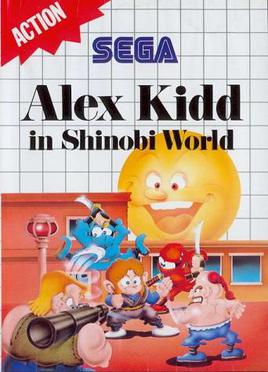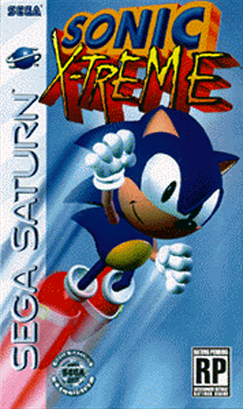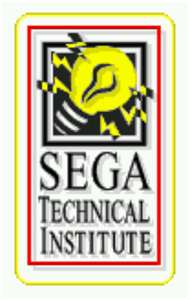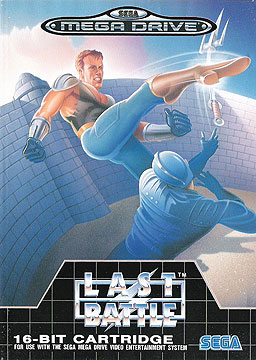
Nights into Dreams is a 1996 action game developed by Sonic Team and published by Sega for the Sega Saturn. The story follows the teenagers Elliot Edwards and Claris Sinclair, who enter Nightopia, a dream world where all dreams take place. With the help of Nights, an exiled "Nightmaren", they begin a journey to stop the evil ruler Wizeman from destroying Nightopia and consequently the real world. Players control Nights flying through Elliot and Claris's dreams to gather enough energy to defeat Wizeman and save Nightopia. The game is presented in 3D and imposes time limits on every level, in which the player must accumulate points to proceed.
Sonic Team is a video game developer owned by the Japanese video game company Sega as part of its Sega CS Research and Development No. 2 division. Sonic Team is best known for its namesake long-running Sonic the Hedgehog series and games such as Nights into Dreams and Phantasy Star Online.

The Master System is an 8-bit third-generation home video game console manufactured and developed by Sega. It was originally a remodeled export version of the Sega Mark III, the third iteration of the SG-1000 series of consoles, which was released in Japan in 1985 with graphical capabilities improved over its predecessors. The Master System launched in North America in 1986, followed by Europe in 1987, and then in Brazil and Korea in 1989. A Japanese version of the Master System was also launched in 1987, which features a few enhancements over the export models : a built-in FM audio chip, a rapid-fire switch, and a dedicated port for the 3D glasses. The Master System II, a cheaper model, was released in 1990 in North America, Australasia and Europe.

Phantasy Star is a role-playing video game (RPG) developed by Sega and released for the Master System in 1987. One of the earliest Japanese RPGs for consoles, Phantasy Star tells the story of Alis on her journey to defeat the evil ruler of her star system, King Lassic, after her brother dies at his hands. She traverses between planets, gathering a party of fighters and collecting the items she needs to avenge her brother's death and return peace to the star system. The gameplay features traditional Japanese RPG elements including random encounters and experience points. All the characters have predefined personalities and abilities, a unique element compared to the customizable characters of other RPGs of the era.

Sonic Adventure is a 1998 platform game developed by Sonic Team and published by Sega for the Dreamcast. It was the first main Sonic the Hedgehog game to feature 3D gameplay. It follows Sonic the Hedgehog, Miles "Tails" Prower, Knuckles the Echidna, Amy Rose, Big the Cat, and E-102 Gamma in their quests to collect the Chaos Emeralds and stop Doctor Robotnik from unleashing Chaos, an ancient evil. Controlling one of the six characters—each with their own abilities—players complete levels to progress the story. Sonic Adventure retains many elements from prior Sonic games, such as power-ups and the ring-based health system. Players can play minigames such as racing and interact with Chao, a virtual pet.

Sonic the Hedgehog is a 1991 platform game developed by Sonic Team and published by Sega for the Genesis/Mega Drive. It was released in North America on June 23 and in PAL regions and Japan the following month. Players control Sonic the Hedgehog, who can run at near supersonic speeds; Sonic sets out on a quest to defeat Dr. Robotnik, a scientist who has imprisoned animals in robots and seeks the powerful Chaos Emeralds. The gameplay involves collecting rings as a form of health, and a simple control scheme, with jumping and attacking controlled by a single button.

Yuji Naka, credited in some games as YU2, is a former Japanese video game programmer, designer and producer. He is the co-creator of the Sonic the Hedgehog series and was the president of Sonic Team at Sega until his departure in 2006.

Shinobi (忍) is a side-scrolling hack and slash video game produced by Sega, originally released for arcades on the Sega System 16 board in 1987. The player controls ninja Joe Musashi, to stop the Zeed terrorist organization from kidnapping students of his clan.

Alex Kidd in Shinobi World is a side-scrolling action game from Sega for the Master System in 1990. Developed in Japan, it was released for the overseas market. The game stars Alex Kidd in a parody version of Sega's ninja-themed action game Shinobi, where Alex Kidd fights against caricatures of many of the enemies from Shinobi. It was re-released for the Wii Virtual Console in 2009.

Fist of the North Star is a Japanese manga series written by Buronson and illustrated by Tetsuo Hara. It was serialized in Shueisha's shōnen manga magazine Weekly Shōnen Jump for 245 issues published from 1983 to 1988 and initially collected in 27 tankōbon volumes under the Jump Comics imprint. Set on a post-apocalyptic Earth after a nuclear war, the story centers on a warrior named Kenshiro, the successor of a deadly martial art known as Hokuto Shinken, which gives him the ability to kill his opponents by striking their secret vital points, which often results in an exceptionally violent and gory death. Kenshiro dedicates his life to fighting against the various gangs, bandits, and warlords who threaten the lives of the defenseless and innocent, as well as rival martial artists.

Kung-Fu Master, known as Spartan X in Japan, is a side-scrolling beat 'em up developed by Irem as an arcade video game in 1984, and distributed by Data East in North America. Designed by Takashi Nishiyama, the game was based on Hong Kong martial arts films. It is a loose adaptation of the Jackie Chan, Sammo Hung, and Yuen Biao film Wheels on Meals (1984), called Spartan X in Japan, with the protagonist Thomas named after Jackie Chan's character in the film. The game is also heavily inspired by the Bruce Lee film Game of Death (1972), which was the basis for the game's concept. Nishiyama, who had previously designed the side-scrolling shooter Moon Patrol (1982), combined fighting elements with a shoot 'em up gameplay rhythm. Irem and Data East exported the game to the West without the Spartan X license.

Sonic X-treme was a platform game developed by Sega Technical Institute from 1994 until its cancellation in 1996. It was planned as the first fully 3D Sonic the Hedgehog game, taking Sonic into the 3D era of video games, and the first original Sonic game for the Sega Saturn. The storyline followed Sonic on his journey to stop Dr. Robotnik from stealing six magic rings from Tiara Boobowski and her father. X-treme featured open levels rotating around a fixed center of gravity and, like previous Sonic games, featured collectible rings and fast-paced gameplay.

Sonic the Hedgehog is a video game series and media franchise created by the Japanese developers Yuji Naka, Naoto Ohshima, and Hirokazu Yasuhara for Sega. The franchise follows Sonic, an anthropomorphic blue hedgehog who battles the evil Doctor Eggman, a mad scientist. The main Sonic the Hedgehog games are platformers mostly developed by Sonic Team; other games, developed by various studios, include spin-offs in the racing, fighting, party and sports genres. The franchise also incorporates printed media, animations, feature films, and merchandise.

Sega Technical Institute (STI) was an American video game developer owned by Sega. Founded by the Atari veteran Mark Cerny in 1990, STI sought to combine elite Japanese developers, including the Sonic Team programmer Yuji Naka and his team, with new American talent. STI developed games for Sega Genesis, including several Sonic the Hedgehog games, before it was closed at the end of 1996.

Sonic the Hedgehog 2 is a 1992 platform game developed by Sega Technical Institute (STI) for the Sega Genesis. Players control Sonic as he attempts to stop Doctor Robotnik from stealing the Chaos Emeralds to power his space station. Like the first Sonic the Hedgehog (1991), players traverse side-scrolling levels at high speeds while collecting rings, defeating enemies, and fighting bosses. Sonic 2 introduces Sonic's sidekick Miles "Tails" Prower and features faster gameplay, larger levels, a multiplayer mode, and special stages featuring pre-rendered 3D graphics.

Last Battle: Legend of the Final Hero is a side-scrolling martial arts beat 'em up released for the Mega Drive/Genesis in 1989 by Sega. It was one of the six games that were available as part of the Genesis launch lineup in the U.S. The Japanese version, titled Shin Seikimatsu Kyūseishu Densetsu: Hokuto no Ken, is based on the manga and anime series Fist of the North Star. Since the international version did not retain the Hokuto no Ken license, the graphics and characters' names were altered. It was the second Hokuto no Ken game released by Sega, following the Mark III original, released internationally as Black Belt. Versions for the Commodore 64 and Amiga based upon Last Battle were developed and released by Elite in Europe in 1991.

Fist of the North Star is a 2D competitive fighting game produced by Sega and developed by Arc System Works, based on the manga series of the same name. It was originally released in 2005 as a coin-operated arcade game for the Atomiswave hardware. A PlayStation 2 port, retitled Hokuto no Ken: Shinpan no Sōsōsei Kengō Retsuden, was released exclusively in Japan in March 2007. This version features a bonus DVD including an exclusive training mode and a documentary covering history of previous Hokuto no Ken titles for home consoles. The arcade version was officially distributed by Sega in North America, while the PS2 port was released only in Japan. In 2020, a homebrew conversion was released for the Dreamcast.

Fist of the North Star is a side-scrolling action video game produced by Toei Animation and developed by Shouei System for the Nintendo Entertainment System (NES). It was first released in Japan under the title Hokuto no Ken 2 on April 17, 1987, being the second Hokuto no Ken video game released for the Family Computer (Famicom) by the anime production company, while also serving as a tie-in to the Hokuto no Ken 2 anime series which began airing on Fuji TV a few weeks earlier. Taxan published the localized NES version in April 1989, making it one of the earliest Fist of the North Star products released in the U.S. alongside Viz Communications' English adaptation of the manga.

Fist of the North Star: Lost Paradise is an action role-playing video game developed by Ryu Ga Gotoku Studio and published by Sega for the PlayStation 4. It is based on the manga franchise Fist of the North Star by Buronson and Tetsuo Hara, and features the gameplay and mechanics of Sega's Like a Dragon game series. It was released in Japan on March 8, 2018 and worldwide on October 2, 2018.


















